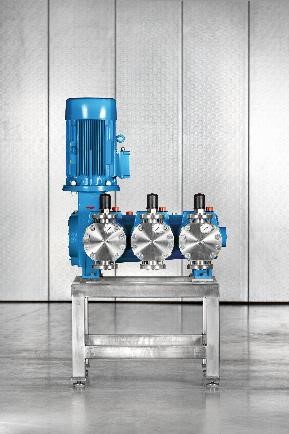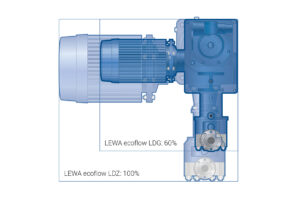New triplex Diaphragm Pump in Monoblock Design for Low-Pulsation Metering

The LEWA triplex G3E is the smallest of its kind to date. (Image source: LEWA GmbH)
There are other pollutants as well, like sulfur and nitrogen oxides. When it comes to clean alternative fuels, liquid ammonia (NH3) is currently coming to the fore, but it is toxic to both humans and animals and extremely harmful to the environment. This is why the pumping technology used must be compact and low-pulsation, and also hermetically tight. Moreover it must ensure maximum operational reliability. To cover these requirements in different output ranges, LEWA is presenting its triplex diaphragm pumps in a new size at this year's SMM. With an hydraulic power of 10 kW, the LEWA triplex G3E is the smallest of its kind to date and offers a low-pulsation alternative to single-head pumps in the medium power range.
"Dual-fuel drives for two-stroke marine diesel engines have been on the rise in the market for several years," said Thomas Bökenbrink, Lead Product Manager Pumps at LEWA. "They are designed to reduce emissions and fuel consumption, since they enable a high degree of flexibility with regard to the fuels used." With the development of processes for the sustainable production of hydrogen (H2) via electrolysis on an industrial scale using renewable energies, liquid ammonia (NH3) is now also coming into focus as a sustainable fuel in this context. However, the gas is highly toxic and very harmful to the environment. This is why fail-safe, hermetically tight pump technology is required to move NH3 safely and reliably in the vessel and inject it into the engine precisely. For the fuel gas supply systems (FGSS) in dual-fuel ship propulsion systems with NH3, only high-pressure diaphragm pumps designed without dynamic seals are worth considering.
Monoblock design is efficient and "bullet proof"
In response, LEWA has expanded its portfolio of compact, low-pulsation triplex process diaphragm pumps specifically for medium hydraulic powers with the new LEWA triplex G3E, the smallest size to date. As with all models in the LEWA triplex series, the three pistons in this variant are located in a common crankcase. The monoblock design makes the unit more compact than comparable modular solutions and has fewer individual components like seals and couplings, which makes the machine extremely robust. "LEWA triplex pumps are ideal for use in FGSS," confirmed Bökenbrink. "After all, they are virtually 'bullet proof' and can easily withstand even the highly demanding conditions around handling NH3 as a fuel."
Thanks to its robustness, the LEWA triplex G3E can run significantly faster than modular three-headed pumps. It has a permissible stroke frequency of up to 350 spm, which is very high for this size range, thus achieving a maximum flow rate of around 20 m³/h at 16 bar. However, pressures of up to 400 bar are also possible at lower flow rates. With these technical specifications, the new development closes a crucial gap – also in terms of overall project costs, as Bökenbrink explained: "With the new triplex process diaphragm pump, a jump to the next larger machine can often be avoided. Above all, this reduces the investment costs for users."
LEWA will present the new LEWA triplex G3E at this year's SMM, one of the leading trade fair and conference events in the maritime industry, from September 3 to 6, 2024 in Hamburg.
Source: LEWA GmbH







